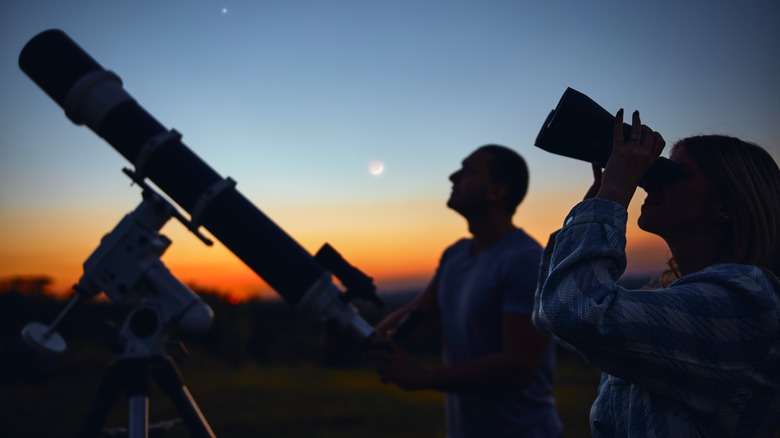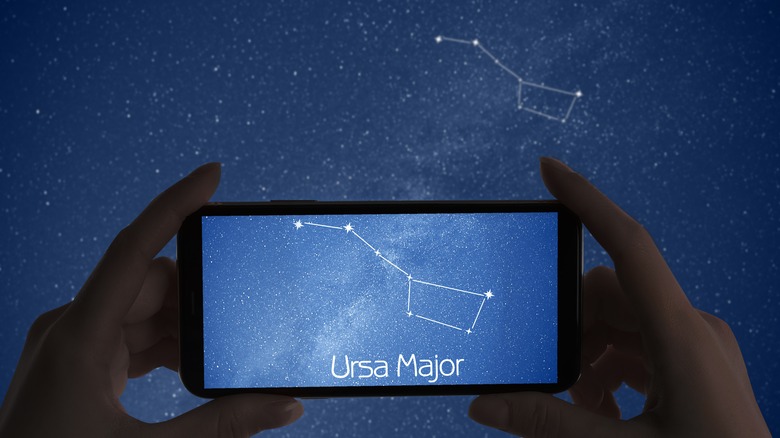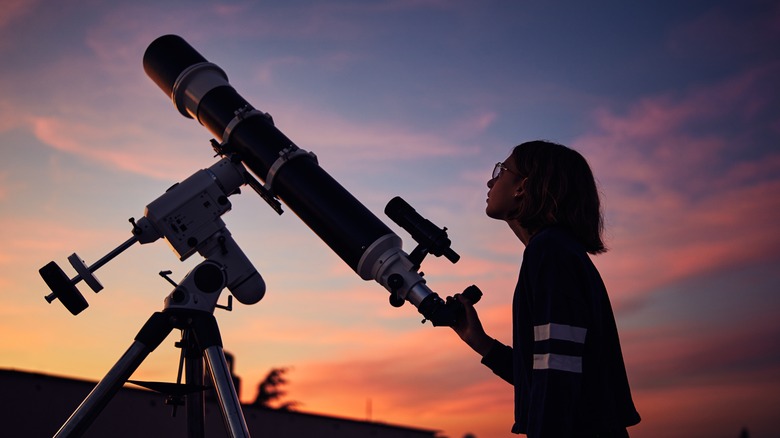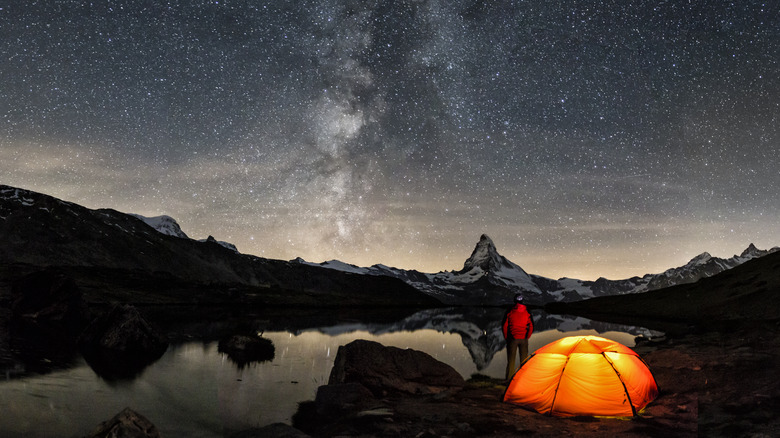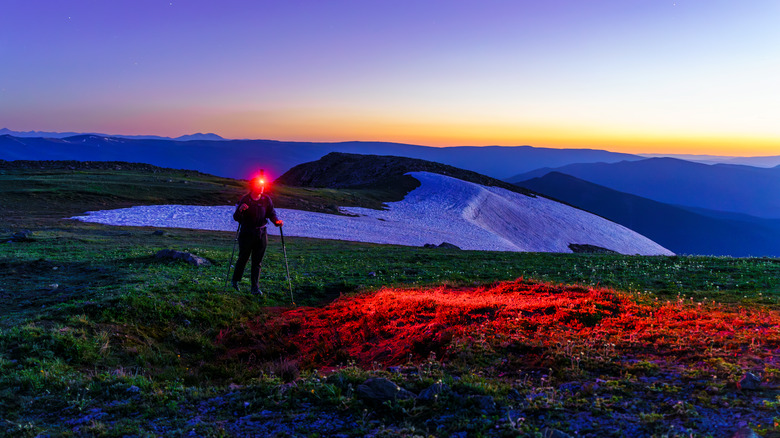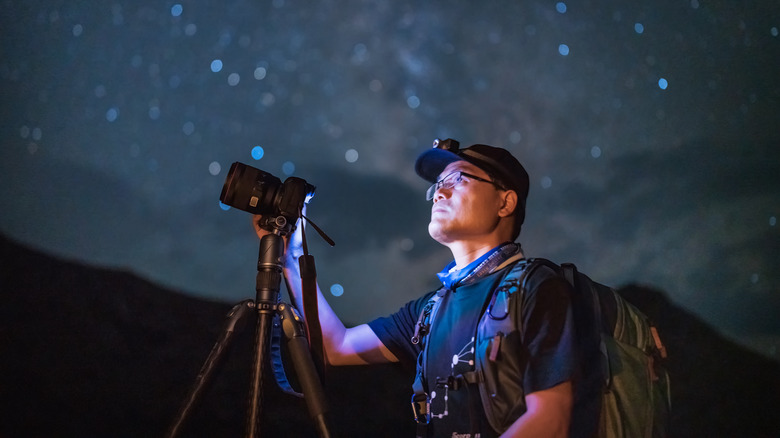5 Tips And Useful Tech For Beginner Stargazers
Our galaxy is a vast and magnificent place, teeming with stars, planets, and nebulas. The sight of the stars twinkling in a clear night sky is absolutely breathtaking, and it's the kind of sight you can get nearly anywhere in the world. If you want to get a little peek behind the curtain of the cosmos, you too can get your start as a stargazer, hunting down the best spots in your neighborhood and beyond to try to see every last constellation glimmering in the sky.
Depending on where you live, seeing the night sky in its unfiltered splendor may be as simple as just looking up. But in most cases, if you really want to get the ideal experience, you're going to need a few helpful gadgets, not to mention some tips and tricks. The cosmos doesn't bare its secrets to the uncommitted, after all, and with the right gear, the sky will become a veritable garden of astronomical flowers, ready for your appreciation.
Find a patch of clear sky with stargazing apps
Stargazing can be a lot harder if you live in a dense, metropolitan area due to the prevalence of light pollution. The various lights of a city reflect off the night sky, turning the whole view into a uniform blur. This is why when hunting for stargazing spots, the rule of thumb is "less civilization, more stars." If you can get somewhere a bit more natural and elevated, like a hill in a nature preserve, you'll have a much clearer view of the sky.
If you're having difficulty finding the best spots, there are a variety of stargazing smartphone apps that can point you in the right direction. Services like Nightshift Stargazing keep track of the weather and relative position of the stars to let you know what heavenly highlights may be visible on a given night, and whether or not local atmospheric conditions are ideal for viewing. You can use these apps to plan a stargazing trip and hunt down the best spot to set up for the night.
Pick up a basic telescope
The cornerstone of the astronomer's toolbox is, of course, the telescope. While the view of the unfiltered night sky is pretty excellent with your own two eyes, a telescope allows you to see the individual stars and planets in surprising clarity, as well as glimpse the components of the famous constellations.
Since telescopes are a bit of a niche technology, a really fancy one with smart connectivity and automatic adjustment can get pretty expensive — well over $1,000. Thankfully, there are plenty of entry level telescopes you can find online for a few hundred dollars or less, though these may sacrifice things like visual clarity or the convenience of an adjustable tripod. If you're just starting out, such a thing is probably fine for practice purposes. As you get better at identifying the highlights in the night, you can move on up to something with a little more muscle and hardware.
Set up a base camp
The thing about stargazing is that even in its ideal form, it's a very slow-going pastime. The movement of the stars (or rather, the illusion of movement created by the Earth's rotation) can take hours just to budge a couple of relative inches. This means that if you're looking for a particular star or constellation, you're gonna be out there for a while, so you'd better set up a spot to get comfortable.
Bring a slanted observation chair that you can use for both checking your telescope and just quietly lounging, as well as a camping table to keep your belongings off the ground. You might also want to bring a portable power supply, as the best stargazing spots are generally pretty far from an outlet. Don't forget to bring comfortable, protective clothing as well; if it's warm out and you're pretty sure it'll stay that way, it's less of a concern, but if it's chilly, make sure you're properly bundled up and shielded from the elements.
Preserve your night vision with a red flashlight
Your ability to properly perceive the night sky is heavily reliant on your eyes adjusting to the darkness. If your eyes are used to bright, white light from the daytime, it's going to take anywhere from 20 to 60 minutes for your eyes to get used to the dark and properly pick up the soft lights of the stars. This is why when you're stargazing, you should endeavor to keep artificial light to an absolute minimum, as even a quick flash of light from your phone or your car can reset your eyes and force them to adjust again.
Of course, when you're under the stars in the dark, it can be a bit tricky to find your way around, and the last thing you want is to trip over something while trying to find your camping snacks. In such a case, a red-light flashlight can be a lifesaver. A flashlight with a red LED, either in your hand or in a headlamp, can light your way around the campsite without forcing your eyes to readjust.
Go further with astrophotography
While it's not required for casual stargazing, if you're interested in capturing the beautiful cosmic canvas to appreciate later, you should get some practice with astrophotography. This purpose would be best served by a professional-grade camera equipped with a wide-angle lens and an intervalometer for capturing long-exposure star trails. Of course, professional-grade cameras, much like professional-grade telescopes, are prohibitively expensive. So, if you want to get some practice, it's okay to just use the camera on your smartphone.
You can pick up a cheap tripod mount for your smartphone to stabilize it on the ground, then switch the camera app to night mode to better capture the sky. While your pictures won't be professional-level, you'll still get some truly breathtaking snapshots in the right spot. Don't be afraid to experiment with your camera app's timer function as well if you want to take some long-exposure shots. Just remember that you'll need to leave the camera running for a while, so make sure you've got external power to keep it running.
